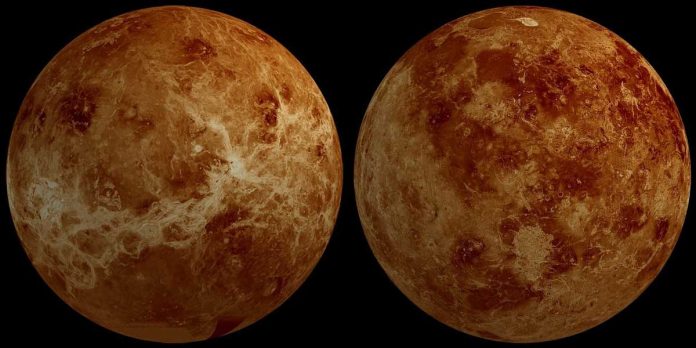The atmosphere of Venus is thick with carbon dioxide and its surface is hot enough to melt lead. The planet is a scorched and suffocating wasteland and life can not survive in it. The cloud is hostile which blankets the planet in droplets of sulfuric acid which can burn a hole through human skin.
A new study supports the idea that if life exists in Venus, it will make its home in Venus’ clouds. MIT, Cardiff University, and Cambridge University researchers have identified a chemical pathway that can neutralize life in Venus’ acidic environment. Its habitants will create a self-sustaining, habitable pocket in the clouds Venus.
In the atmosphere of Venus, scientists have noticed puzzling anomalies like chemical signatures that are hard to explain. They have observed small concentrations of oxygen and nonspherical particles such as sulfuric acid’s round droplets. Ammonia is also present there, a gas that was tentatively detected in the 1970s. But this gas should not be produced through any chemical process known on Venus.
The researchers modelled a set of chemical processes. They showed that if ammonia is present, it set off a cascade of chemical reactions to neutralize surrounding droplets of sulfuric acid. This model explains the anomalies observed in Venus’ clouds. The source of ammonia can be explained from Venus’s biological origin rather than any nonbiological source.
The new study suggests “life could be making its own environment on Venus.”
The researchers have tested this new hypothesis. Researchers provided a list of chemical signatures to measure in Venus’ clouds. Future missions to Venus will either confirm or contradict their idea.
The study co-author and the Class of 1941 Professor of Planetary Sciences in MIT’s Department of Earth, Sara Seager said that life as we know it can not survive on Venus, but maybe some life is there.
Life Suspect
Scientists have detected phosphine in Venus’s clouds. Phosphine is produced mainly through biological interactions on Earth. Through the discovery of phosphine on Venus, scientists suspect the possibility of life in the planet. This discovery has been widely contested. The finding of phosphine was controversial.
This has inspired scientists to look more closely to the data from past missions to Venus. Scientists found anomalies in the cloud. In the presence of oxygen and nonspherical particles, anomalies or chemical signatures have levels of water vapor and sulfur dioxide.
Scientists said that anomalies can be explained by dust. Minerals, swept up from Venus’ surface, can interact with sulfuric acid to produce anomalies. Though the chemistry of this explanation was fine but the physical requirements were unfeasible. As a massive amount of dust have to loft into the clouds to produce the anomalies.
Scientists tried to explain the anomalies by ammonia. In the 1970s, ammonia was tentatively detected in Venus’s cloud by the Venera 8 and Pioneer Venus probes. The presence of ammonia in the cloud is an unsolved mystery to scientists.
According to scientists, ammonia should not be there in Venus. Ammonia has hydrogen and there is no hydrogen around in Venus.
Liveable clouds
The researchers modelled a series of chemical processes in order to find out if life was the source of ammonia on Venus, can this explain other anomalies in Venus’ clouds?
They found out if life is producing ammonia, then the associated chemical reactions would naturally produce oxygen. Ammonia can be dissolved in droplets of sulfuric acid. The acid will be neutralized to make the droplets relatively habitable. Ammonia will first dissolve in sulfuric acid and then it would make any surrounding sulfur dioxide to dissolve as well.
Then the presence of ammonia can explain most of the major anomalies seen in Venus’ clouds. The researchers also think that lightning, volcanic eruptions and meteorite strike cannot produce the amount of ammonia needed to explain the anomalies.
The researchers said that the stomach of a human being produces ammonia to neutralize in a highly acidic environment.
The scientists will get chances to survey the presence of ammonia and signs of life in Venus with the Venus Life Finder Missions. Scientists will send a spacecraft on Venus to measure its clouds for ammonia and other signatures of life.

